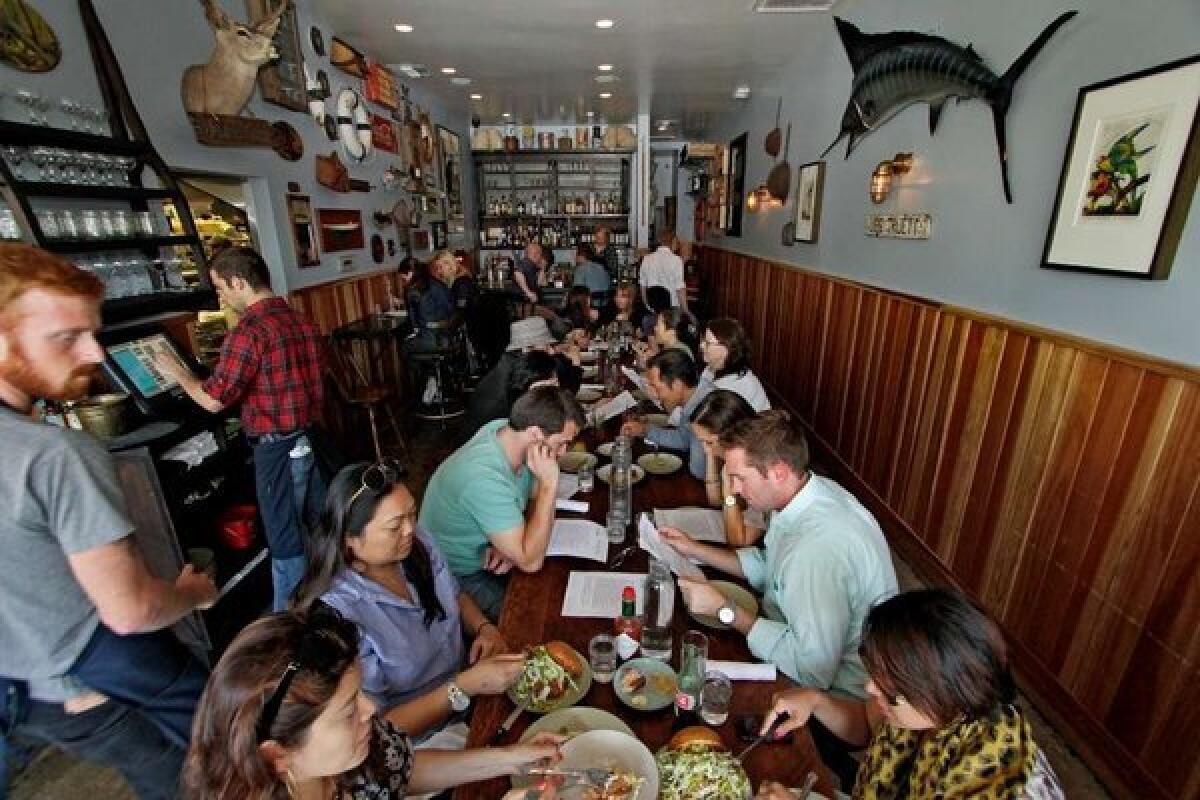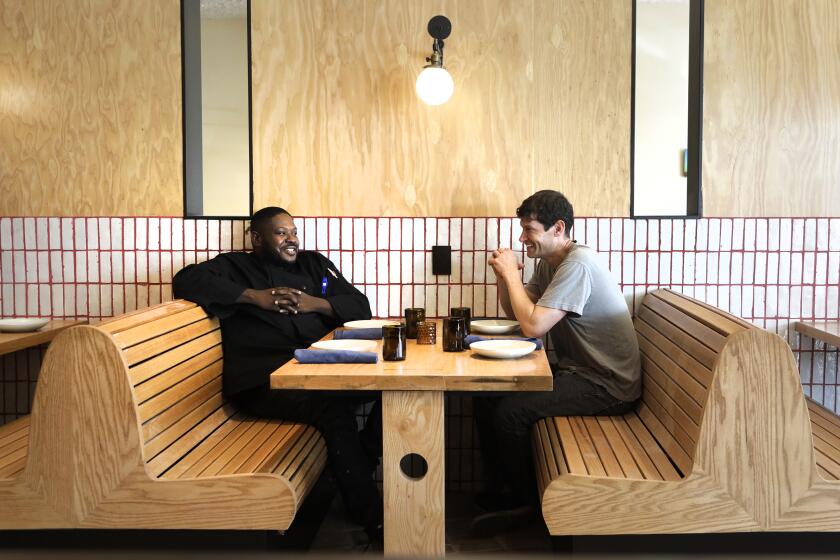Small plates dining: Train wreck or terrific?

The issue of small plates reared its head again recently when the Washington Post published economics columnist Neil Irwinâs âThe Case Against Small Platesâ and Matthew Yglesias responded with âIn Defense of Small Platesâ on Slate. (Tyler Cowen at Marginal Revolution weighed in too.)
One of Irwinâs complaints about small plates (âa tool for punishing those who just want an honest mealâ) was that dishes are sent out from the kitchen as theyâre ready instead of being coursed out. That same complaint came up during the latest âLunchtime With Mr. Goldâ (the weekly live chat in which readers ask dining questions to L.A. Times restaurant critic Jonathan Gold). Are small plates a train wreck for the table?
Posited Steve: âWhat are your thoughts on places like Animal, Fundamental and the Sunny Spot that send dishes out as theyâre prepared, so some people in your party might get their entrees before their starters or everything they order at once, with another poor soul in your party plateless until later in the meal if no oneâs sharing (not always easy to do when many people have dietary restrictions)? I love the food at these places, but that drives me crazy and I feel like it shows a lack of respect for diners. Am I alone?â
Probably not, but the fact is, same-time coursed dishes -- when everyone at the table receives their appetizers at once, followed by their entrees simultaneously -- are going the way of, well, newspapers. According to Yglesias, thatâs a good thing. âI think we should see the shift toward small plates as being comparable to the differences between websites and newspapers.... By lowering the barrier to entry, you encourage more experimentation and more innovation.â
But how do chefs explain why everything must be sent to the table on their schedule? Why did your friend get her beets and burrata while youâre still waiting for your fried rabbit liver with jerk sauce?
Firstly, the small plates concept dictates that dishes be shared. (Whether or not you want to eat some of your friendâs beets is up to you.)
âWe donât do it this way because itâs necessarily easier for us or to dictate how you eat,â says Rustic Canyon chef Jeremy Fox. âIf youâre coming to a restaurant, youâre not just coming because you need to fulfill your daily calorie intake. Itâs about celebrating good food, good service and good wine. I think sharing promotes a more festive atmosphere: passing plates around, âyouâve got to try this,â picking off the plate, I associate these things with really enjoying the meal.â
And you want to start enjoying the meal as soon as possible, right? At a busy restaurant that has a lot of customers, chefs say that sending food as itâs prepared ensures that people always have food on the table -- theyâre not waiting for all of the appetizers to come out at once or all of the entrees to come out at once. (But letâs not be coy, it does also help turn tables, so that other people can start enjoying their meals, too....)
Then there are also a lot of dishes on the menu -- thatâs the point, right? -- so diners get to try a lot of different tastes. The Bazaar by Jose Andres, for example, has 69 dishes on its menu, not including dessert. Animal and Son of a Gun have about 30, and Susan Fenigerâs Street more than 20.
And getting two, three or even four dishes per person (for a table of four thatâs eight to 16 dishes) requires a lot of coordination. Coordination between the expediter (the person in charge of telling the kitchen when to fire the food and then making sure it gets to the right table at the right time) and the cooks, as well as between each cook at each station. Also, as an aside, âjust because itâs a small dish doesnât mean it requires less work, space or equipment than a large dish,â points out Feniger.
The expediter and servers should be keeping an eye out to see how many dishes and which dishes are at the tables and to coordinate as best they can. The intention is not a willy-nilly parade of food. âIf somebody orders the hamachi, squash salad, meatballs and chicken, weâre not firing the meatballs and chicken with the hamachi,â says C.J. Jacobson of Girasol. âSquash and hamachi are first always. Itâs a delicate plate of hamachi with a teeny bit of citrus. We serve it with what makes sakes sense for the palate.â
Feniger says she tries to honor requests to send plates out to diners in simultaneous courses. âBut for a small kitchen, that means the window (where the plates are put once theyâre finished) gets really crowded and kind of backs everything up.â
Meanwhile, your food is sitting there. âWhen everything comes out in a coursed manner, things are going to sit,â Fox says. âSalads are going to sit for longer than they should after theyâre dressed. Or maybe something will sit under a heat lamp.
âI donât feel like itâs worth it to have the food suffer because thatâs the way things have been traditionally done in a restaurant. It comes down to creating the best atmosphere for each restaurant. Iâd rather it be as well done as possible and go out to the table right away.... Itâs 2013, how we eat is always evolving.â
ALSO:
Why Valentino is no longer for sale
Depressed Cake Shop pops up in L.A.
EMC Seafood & Raw Bar: Itâs Son of a Gun for K-Town
More to Read
Eat your way across L.A.
Get our weekly Tasting Notes newsletter for reviews, news and more.
You may occasionally receive promotional content from the Los Angeles Times.











